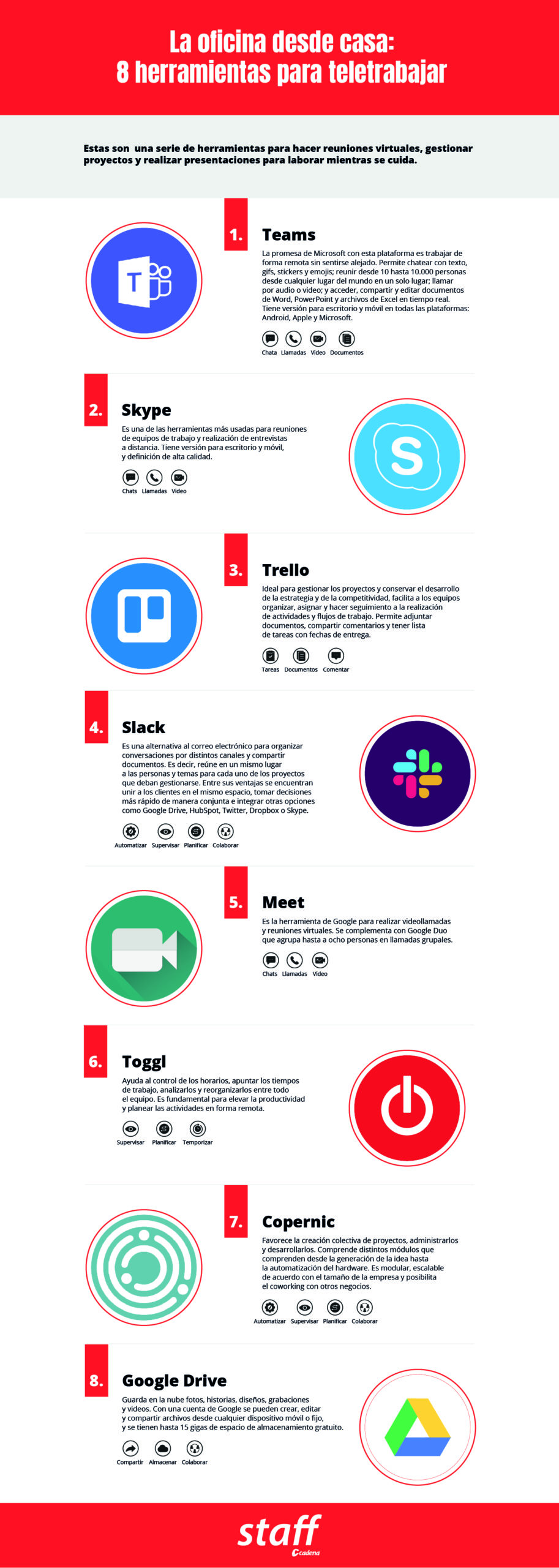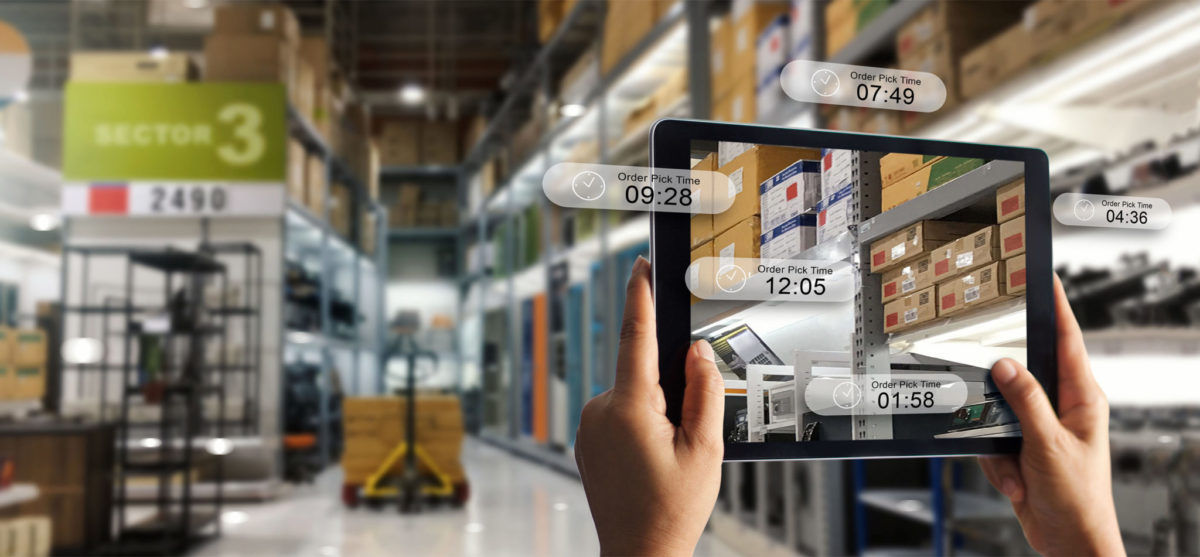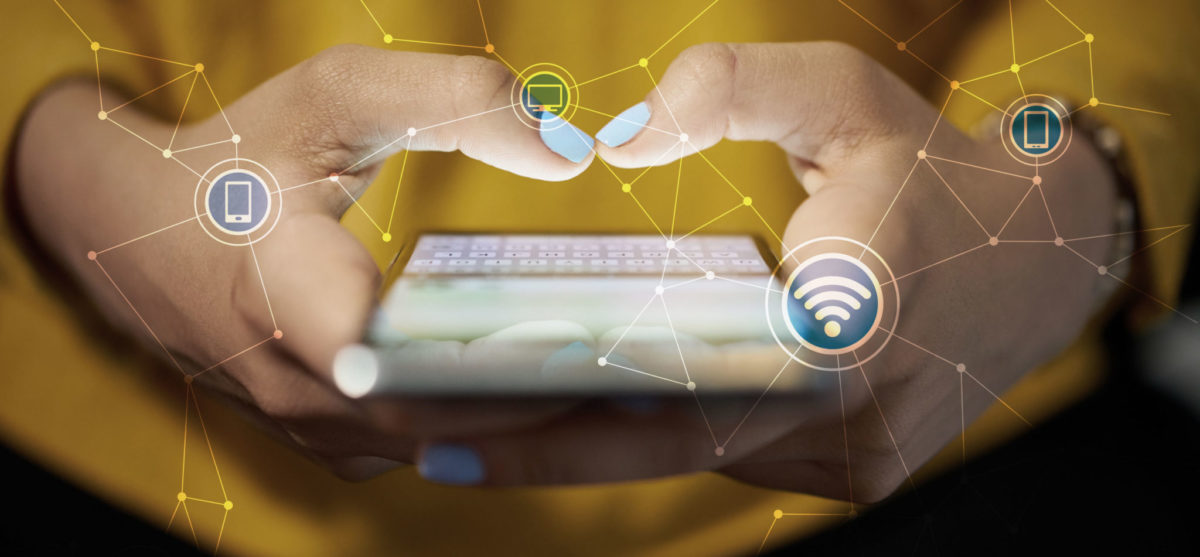8 tools for teleworking




The digital transformation has brought with it a number of products, habits and processes, which have provided efficiency and an absolute improvement for the relationship with the client. In today’s business, the customer demands recognition, and the way it can be achieved is through CRM.
The first technological requirement for optimal customer service is the CRM, since this platform will be the repository of all the information on the customer’s profile (age, gender, profession, tastes and preferences), their behavior (purchase frequency, type of products you purchase , among others), and your attitude (complaints, suggestions, requests) and therefore, there the information required for the generation of algorithms will be obtained, an essential requirement of any technological aid supported by Artificial Intelligence.
For the preparation of this article, we were accompanied by Luis Fernando Botero Carrasquilla, Business Administrator, with more than 10 years of experience in business, management and marketing consulting; postgraduate professor at the Javeriana University and former columnist in the magazines Dinero and Portafolio. Currently, he is the manager at BJ Consultores and CEO of Csmart SAS
As technological support for all information, the CRM is the champion. “There is no advance in artificial intelligence, be it chatbots or any automation, that does not require the support of information in real time of all the interactions between the client and the company, to guarantee an excellent service.
“The different contact channels that an organization may need to be articulated . All responses and contacts must be integrated into the CRM so that there is consistency in the response: what is spoken to the same customer by email and social networks must always be aligned; because the client is not willing to tell the same story every time the brand communicates with him”, confirms Luis Fernando Botero.
Many companies make the mistake of opening accounts through all channels, be it: email, website, social networks, chatbots , customer service line and others; but within these accounts, there is no integrator that consolidates the issues in each contact and allows the agent to respond to the client; have the information to prevent the customer from having to repeat it and also be sure that he or she is not a single customer for the entire company, but a different person for each contact channel. On average, consumers use three contact channels and 60% expect not to have to repeat their problems to other agents.
Multichannel means that the brand offers multiple contact channels; but, in addition, it has very clear requirements: quick responses (within minutes for any channel), effective solutions, recognition, among others. Offering multiple contact channels requires effective management of each one.
Omni -channel means that customer management for each contact channel is consistent, that is, regardless of the contact channel, the customer feels recognized, he does not have to repeat what he already said to the first agent with whom he spoke and the answers, Regardless of the channel, they generate satisfaction and are an express manifestation of its importance for the brand as a whole.
This is how CRM goes beyond being a software; its incidence is such that it becomes a customer-focused business strategy. CRM as such is not a new term; What is new is all the technology that allows you to do what traditionally was done in neighborhood stores: the owner could have few customers, but enough memory to know and remember what each one liked. And that’s exactly what the technology is trying to do right now: it allows us to go back to that kind of model.
However, today’s business model requires immediate responses to users and definitive solutions. All digital contacts must recognize the client and this cannot always be the provider of the information. It is at this point where the need for internal support arises, a technological help application.

Currently, technology allows various options, with technological devices in customer service:
These technological devices build customer loyalty and recognize them , allowing them to place them in the context of how much they have bought and what they have bought; in order to be able to follow up and offer you possible maintenance or renewal of the product or service at a certain time. In short, it is like a potential observer of customer behavior when buying, and keeps track of their history, their tastes, preferences, important dates, and more.
The best communication days to have with the client depend on the sector and the industry: they are circumstances that must have special consideration. There are times when the peaks skyrocket, so the days depend on the seasons. For example, educational institutions have their peaks in the weeks prior to enrollment; beginning and middle of the year. Hotels and resorts have their peaks in the weeks or months prior to vacations and holidays and thus, each company has its seasons: the type of business provides the information.
“When that moment arrives, the brand must be prepared to enable all available contact channels and ready to generate immediate information. And of course, being in total synchrony with all the means of communication”, complements Botero.
Customer service is a strategic responsibility and cuts across the entire organization. At all times, the leader of the customer service area must attract all areas of the company to be aware and provide immediate support to the needs of any employee who requires it or client who needs it. This is a model that must be permanent, all employees of the organization must feel and understand the client. Regardless of the area, there must be a guarantee of support when it is needed, be it in human resources, the financial area, the legal area and all the others.
The CRM must have a user in each employee of the company and through him, all the agents will communicate to guarantee that the answers have the “tracking” so that any agent facing the client, knows the characteristics of the client and the urgency of their requests. requests.
Being the telephone the preferred channel for users, chat , social networks and all digital channels are growing rapidly. The reason is the speed in the responses. People who have grown tired of hotlines have chosen to make their problems public through social networks, with the consequent risk for brands, and given this reaction, companies see the need to act more quickly.
When there is a breach in a service or a failure in a product, that is when technology must emerge and companies must take advantage of it. Activating an alert system, whether by SMS, chat, mail and others, will be essential to send response messages to customers who were breached or received a defective product. Always apologize for the inconvenience and say that the company is working to fix it as soon as possible. This is proactive customer service .
Companies with excellent customer service behaviors, such as Amazon, Nordstrom, Apple, Zappos, Southwest Airlines, Uber, Airbnb, Sura, Bancolombia, among many others, have worked tirelessly to build loyalty and create the best experiences for their customers. And of course, they have had excellent CRM and other technologies as allies.
At Cadena we tell our entrepreneurs: these days #StayAtHome and use digital channels.
The CRM optimizes the customer’s life cycle in its entirety since it is the support to generate memorable experiences for all customers. It generates alerts to respond proactively and, in addition, values each client so that, depending on their value to the company, they receive a service according to it.

The Coronavirus has generated a disruption in the market, leaving companies more prepared for collaboration and digital connectivity with a competitive advantage. The relevant question at this time is: How prepared is your company to work digitally?
The reality that the world is experiencing leaves businesses with an immense challenge that will undoubtedly accelerate the home office culture , this being one of the ways to protect themselves from this global pandemic. But, how prepared are companies to implement information technology (IT) in their processes from the homes of their workers?
Given the increase in cases of COVID-19, technologies promote remote work, both for its employees and customers and users. These changes, which seem untimely and occur randomly, are bringing with them a more intense home office culture .
For this article, we have the advice of Systems Engineer and Master in Senior Management: Andrés Felipe Robledo Zapata, with more than 17 years of experience in IT, 17 years in which he has been a participant in different digital transformations in companies in which that has been.
It is a fact: more and more technologies are joining the measures against the Coronavirus. “Although personal interaction in business generates much more empathy, such as gestures and visual interaction; we are being forced to do it virtually; For this reason, we have to learn to communicate through digital platforms , and this requires certain skills” Robledo affirms.
The companies that have been working under this telework model have a great competitive advantage at this time, because for them it will be transparent: their teams are already used to working under this model and its impact on the efficiency and effectiveness of the company will be smaller. While those who have not done it and are just going to dabble, are in the process of understanding and looking for how to do it, making a change in the culture of people to get them to really connect and know how to work collaboratively: work as a team , in the same file, through collaboration platforms and not through a number of emails, is an example .
However, the solution does not only lie in practicing remote work ; people should start having hygiene from the point of view of the home office , because this requires a series of rituals and good practices:
Today, the market offers a large list of platforms, whose goal is to synchronize people: connect them with others virtually and provide them with the best possible experience. Thanks to them, companies will have a more coordinated workflow by providing a unified platform for team discussion, file sharing, online storage for documentation, assigned tasks and real-time project collaboration.
Among the most used digital platforms, which promote teleworking and collaborative work more efficiently, are:
However, you have to know how to do it; “technology is useless if we do not have healthy habits of digital communication. This should be integrated with some good skills. Timely planning, impeccable content, and targeted interactions are critical to connecting both internally and externally with customers.” Robledo complements.
Today, there are companies that are dedicated to providing the necessary consulting to adopt these skills to their organizational culture. And in case you want to connect digitally with customers, in a more sophisticated and massive way, there are also production and support companies for virtual events.
It is no longer an option, the crisis that the world is experiencing due to the Coronavirus has raised the health requirements in the world with the aim of preventing the disease from continuing to spread, and this forces companies to change the way they communicate with their different audiences.
Andrés Robledo proposes that “hacking” the culture of companies is a good option to achieve this: “for people to unlearn and change their behavior in the face of technology, implementing a change management strategy.” For this, it is not enough to train employees in its use; day-to-day monitoring and follow-up is necessary to understand how to shape technology as a team to add value in different business scenarios, and for employees to use those functions that add the most value to their role. “Technology alone doesn’t do anything, if you can’t find a business use for it. Technology must fit with the uses and customs of the culture and processes within the organization”.
So cheer up! Companies can turn this contingency into something positive, acquiring healthy home office habits and implementing it properly.

Today’s consumers need immediate and easy access to information. For their part, brands need to relate to their customers in a concrete, fast and efficient way.
The information that the new generations consume is different. Today, the media are generators of extensive and baseless content, which is why the challenge proposes total innovation and calls on brands to be more creative and concrete when it comes to communicating.
Understanding what customers have at home and understanding that they are changing are very important aspects for companies that have entered the path of technological evolution. The conjunction of these two aspects allows us to make a plan that can be adapted and show them the possibilities they have, since the vast majority do not know what they have inside the house.
According to Bruno Neves, a company that wants to innovate must understand the young people who are entering the market and the new professionals who, without a doubt, come with a 100% digital chip. To achieve this, companies must adapt to the mentality of these new generations of millennials and centennials, through an internal innovation culture plan.
The approach to this challenge in organizations is basically what is called digital transformation. Regardless of the business or work, all brands must assume it, improving their information systems and delivering services with the mobility and security characteristics that this challenge brings with it in terms of organizational architecture, processes and training for employees.
Marketing communicates and has very relevant data about customers. However, by itself it would be useless: it needs technology. This mix generates benefits such as better customer perception and the ability to evolve and grow that it demonstrates.
Marketing companies have invaluable wealth: the data they collect from customers. If used appropriately, this data can be used to segment and create messages with special characteristics for different interest groups.
What today’s customers value most is the reliability of the information and that it is truly useful and easily accessible.
To learn more about the practices that have managed to position themselves strongly in the market, innovating through educational content, read this article about Inbound marketing , the trend that has become a fundamental key to digital transformation.

Collaborative business models are gaining more and more prominence. Find out how they work, what their advantages are and what they can bring to organizations.
The fourth industrial revolution brought with it trends such as sharing goods, services and information through digital platforms and it is in this context where the collaborative economy allows the consolidation of new business models , which usually combine old ways of operating with technology.
Being able to choose a transportation service with a click, shopping for second-hand clothes or objects, and getting information before making a decision, demonstrate the importance of this economic model capable of interconnecting the world and breaking down geographical barriers.
Collaborative consumption eliminates the costs and time involved in making transactions through intermediaries. For example, finding an academic advisory or consultancy on a web page, or renting a room in another city directly with the owner, negates the step of looking for an organization that charges for offering this service.
In addition to saving money, the collaborative economy is a benchmark for sustainability due to the positive impacts it generates on the environment: sharing a vehicle, as proposed by carpooling applications , or buying second-hand objects reduces the generation of waste and the emission of polluting gases.
Rollin , for example, is an application created in Colombia to encourage the use of shared vehicles; this venture has achieved close to 30,000 downloads and has approximately 22,000 registered users. Try my ride is another sustainable mobility system that works from a mobile application, in Medellín it has avoided the emission of 21,274 tons of CO 2 and its users have saved close to 114 billion pesos.
One of the axes of this collaborative model is the collaborative finance of which crowdfunding is a part, which seeks the creation and support of social and cultural initiatives. Its success depends on the diffusion and visibility that it is given through social networks and websites.
Verkami is a successful example of crowdfunding models ; Since 2010, nearly 7,830 cultural projects have been financed through this platform, with a success rate of 73%. Vermaki, born in Barcelona, has meant a revolution in cultural demand and supply with close to 39.5 million euros raised by more than a million people.
Vaki is a sample of the incorporation of these collaborative economy models in Colombia , it was created in 2015 to finance social and artistic projects, citizen movements and personal initiatives that contribute to social change, without the need for intermediaries and only with community support.
One of the potentials of the collaborative economy is its ability to foster the exchange of knowledge. At this point, according to Carlos Jaramillo, CEO of Distilled Innovation , companies that emerged in traditional economic models are called upon to link up with those ventures that are characterized by innovation , despite having fewer resources, since they occur in contexts of flexibility. and dynamism.
“The tendency is to learn to co-create. Large and small companies can work together, contributing their knowledge and skills to create new ecosystems”, says Jaramillo.
With the arrival of this new business model, today companies are obliged to rethink their nature and transform themselves not only by acquiring new technologies, but also by opening up to new thoughts, perspectives and ways of doing things , in In other words, evolution must be constant, because in this way it is possible to be sustainable over time and compete with these emerging businesses.
If the organization considers it appropriate to adopt a collaborative economy model, it is key in this process to create awareness about the importance of protecting data, providing relevant information and being transparent.

Captivating a user is a challenge, so providing functions that solve their needs and that are also close to their tastes and affinities is not a plus but a must. Hence the importance of testing.
Users are transformed, the ecosystem is changing, the competition is relentless, and the technology giant has no limits. This is the scenario today for companies, start ups and ventures.
For this reason, the technology teams of any organization in the world must have the capacity to respond to different areas : they have heterogeneous knowledge, they are increasingly specializing and they need to have collaborators who have information and experience in all kinds of skills.
For example, a company that wants to launch an e-commerce will have to consider a multidisciplinary team, in which there is at least one content expert, one or more experts in interface experience and user experience, who also support the exercise of test, additionally, you must have a developer, a digital designer, staff dedicated to the marketing strategies of the online store, an SEO expert and an analytics expert.
Although each step in the chain is important, there is an invaluable task in this exercise and that is testing.
Testing is nothing more than making tests that allow users to interact intuitively , that is, they can express themselves and naturally take ownership of the functions without telling them if their answers are good or bad: everything is valid.
After the interaction, the different answers are analyzed and reviewed by the team of experts and evaluated with some journeys to find out if the users who participated in the test behaved as expected by the technology or functionality that was being tested. With this information, the teams make adjustments and then go productive.
Erika Santa Correa, user experience expert, shares here some ideas about the importance of carrying out a testing process prior to presenting a functionality in production:
“With my knowledge working with teams to design website experiences, these moments have been crucial. For example, once we had a simple and revealing situation when we were designing a premium catalog of items, the design was aesthetically amazing, it had the biggest role in the display of the product. And although the test yielded positive results, there was one point that we did not expect: e-commerce I didn’t have an explicit path to return to the previous menu. Our hypothesis based on previous experiences was that the user would use the basic browsing patterns of the browser, however, users were stuck in a part of the purchase process because they couldn’t find how to get out of the current point; a critical finding for conversion and purchase flows. This finding led us to make some design tweaks by explicitly incorporating the way to continue shopping.”
From this case, the importance of applying testing to users is demonstrated, since functions that may seem obvious to the developer team are not really obvious to the user and with this tool you can check and know in detail what should be done . adjust to meet audience expectation. Undoubtedly, a fundamental tool for the marketing strategies of organizations.
There are different types of tests: functional, non-functional, structural, regression, among others. To find out which one is best for your strategy, the first thing you must be clear about is the objective and with this, choose the methodology that helps you solve it.

The different developments and technological innovations have not only generated changes in the ways of being, thinking and relating to others, but also in the way companies communicate with their audiences and persuade them.
What used to be resolved with a call to say “it takes me a while”, today is resolved with a short and quick message via WhatsApp or, it is no longer “I want to work in your company” but “I want you to be in my company ” thanks to the approximation that Linkedin has of a person’s professional profile.
These are just two specific cases of how technology impacts day-to-day communication, breaks down geographical barriers and offers different possibilities in terms of personal and corporate communications, for networking, advertising and educational purposes, among many others.
Email, without a doubt, is one of the most powerful communication tools and this was demonstrated in the 2019 report presented by the Socialbakers digital knowledge platform, which shows that every sixty seconds 188 million messages are sent by email . , a fact that will grow more and more, since it is not only the emails sent from one person to another but all those that companies send to be in contact with their audiences, which is what is known today as email marketing or permission marketing , messages that add to this figure and demonstrate the importance of developing mailing strategies .
Just as email marketing is becoming more relevant , there are other aspects that have also changed in organizations. One of these is the way of storing information, which went from being in large physical folders in an exclusive room to being in a clip or a tap in the cloud, regardless of place or time.
According to Sister María Castaño, an expert in digital transformation and Technology leader in Postobón, today the greatest asset of companies is information, for this reason, “the way of issuing it, receiving it, consulting it, storing it, keeping it, securing it, has changed, share it and rule it ”.
Although sharing information is now much easier, if proper precautions and controls are not taken, this plus point can pose risks for companies. To avoid this, it is essential to have the information centralized and to define clear procedures and protocols that guarantee the proper use of the stored data.
Beyond the changes in the ways of doing things, technology has also had an impact on the behavior of employees.
For Andrés Rozo, a psychologist who is an expert in organizational culture, although this favors business development and enables the sustainability of companies over time, the inclusion of robots and the automation of different processes “creates a scenario that can generate anxiety and threat to employees.” professionals or that represents ambitious challenges for them, since no profession is spared from this reinvention: it is a change that compromises openness, the responsibility of constantly being informed and opening up to new functions, some more strategic that each time add more value to the core of every business ”.
On the other hand, Rozo points out that technology also generates variations in empathy between work teams, for example, the fact of looking less into each other’s eyes, having more contact with the cell phone than with people, creates distances and so that this does not become a problem, companies must permeate among their collaborators a culture of assertive, direct, clear communication and work to strengthen relationships.
It is important to take into account the different generations that are part of organizations today, because in the case of millennials, they see technology as an ally and the centennials, who come after them, cannot imagine life without technology, therefore, it is key that, in addition to promoting the search for trends, co-creation and standardization of knowledge among its employees, fostering spaces for socialization and connection with what is fundamental.

This modality is gaining more strength in the world every day, as it represents a growth opportunity for those companies that need local representation and also for entrepreneurs who want to enter the digital ecosystem with the support of a recognized brand.
The Internet has changed the way we perceive the world, move around and consume, so much so that the business models known as franchises have effectively gone virtual and in recent years have become popular, offering the possibility of investing more safe, with lower costs and good growth opportunities.
Digital franchises are brand licensing that works the same as a physical franchise but on the Internet; in these the franchisee buys the rights to certain geographic areas and obtains profits from mobile and web e-commerce within its marked territory. You also have the rights to leverage the brand and have the back-end systems , as well as training and customer support from the parent or franchisor company.
This type of entrepreneurship has become one of the most profitable investment businesses in the last year, especially in Europe, although in Colombia it is a relatively new concept. If you are thinking of entering the world of digital franchises, it is essential to know a little more about them to ensure that the brand fits your profile, expectations and needs.
Different types of industries can benefit from taking the approach of a digital franchise. This model is ideal for:

Different types of industries can benefit from taking the approach of a digital franchise. This model is ideal for:
The relationship strategies of each franchise vary according to their nature and location. It is essential that the franchisee knows the local and hyperlocal market to identify potential customers who are within their target audiences, in this way they can reach them with the appropriate language and techniques of the franchisor business.
It is a digital services franchise and is the world’s largest Internet consulting firm. It offers thousands of solutions for small and medium-sized businesses and through the use of the patent-pending Lifecycle™ system for Internet Marketing, its franchisees can assess the business needs of their clients in order to deliver marketing strategies focused on generating income.
Entrepreneurs can acquire the license of this brand and start providing digital marketing services to companies and professionals around the world. The company is in charge of giving them the training and the material for the development of the tasks.
It is a network of low-cost franchises that allows you to have your own app, website and social networks positioned to deliver information and value offers on each city for which it is created. It has a presence in Bolivia, Chile, Colombia, Ecuador, Guatemala, Honduras, Mexico, Nicaragua and Panama, which makes it one of the most successful today.
It has many opportunities for continuous growth since it is focused on specific developments according to geographic location, there can be as many franchises as there are cities in the world.

To stand out in the market and be truly competitive, this year companies must take action in terms of technological transformation. These are some of the tools that allow this transformation and that will be protagonists during 2020.
The report on the adoption of digital transformation in companies, presented by the multilatina Internexa , highlights the importance of moving from theory to action in 2020 and to do so, according to its Marketing Director, Jairo Guzmán, is not only necessary to define the appropriate tools but also to have a strategy, and know how to lead and manage cultural change in the organization. Together, this will allow them in the medium and long term to facilitate and improve their processes, therefore, their productivity, efficiency, competitiveness and recognition in the market.
In addition to artificial intelligence, augmented reality, big data or the Internet of Things (IoT), technologies such as 5G telecommunications networks, edge computing and XAAS will stand out in business strategies. What are they about and how can they benefit companies? We tell you below.
5G telecommunications networks are the technological foundation for the development and mass deployment of the Internet of Things.
Thanks to its speed (ten gigabits per second, up to a hundred times better than 4G networks) it allows users to reduce download times, improve connectivity, have lower latency and provide greater capacity so that many more devices are connected at the same time ( up to one hundred devices per unit area).
5G networks will bring great benefits for the use of technologies in areas such as electronic commerce, health, education, finance, the automotive industry, among others.
There are more and more devices connected to the network generating millions of data, from a smart watch, a thermostat, a lamp, a television, a refrigerator to an autonomous car. All the information they gather is sent to large data centers in the cloud to process it, it is what we know as cloud computing , which, although it offers many advantages, also has its limitations, for example, it can be expensive, a bit slow and consume A lot of energy.
Faced with this, edge computing has begun to be implemented , which generally consists of the devices themselves analyzing the data they collect , in other words, it will no longer be necessary to send them to large data centers in the cloud.
Thus, edge computing works as a network of data microcenters that are processed where they are generated, that is, locally. What does this allow? One of its main advantages is to reduce energy consumption, consume less bandwidth and improve latency, that is, the delay between the propagation and transmission of data. In addition, this system provides more security and avoids information saturation in the cloud, a key point since it is estimated that by 2021 there will be more than 30,000 million connected devices in the world thanks to IoT.
The XaaS system offers organizations a variety of solutions ranging from software to storage; includes any computer service that is provided through the Internet and allows the modernization of information technologies , benefiting, for example, the digitization of physical documents, as well as the different areas and processes of companies such as human resources, accounting, security and else.
What are the advantages of XaaS? In general, an adequate implementation of this integrated system of cloud services allows a greater response capacity to changes in the sector, more agility and flexibility, reduces improvement cycles and consolidates the technological transformation of companies much more.
Added to these three technologies, in 2020 robotic process automation (RPA), blockchain, data analytics and conversational artificial intelligence will continue to gain strength in business strategies. To stand out, as indicated by Internexa, the key is to take action.

When technology is at the service of marketing, businesses benefit from better consumer knowledge and the capture of their data to manage, analyze and use it to respond to their needs with timely information.
Industries today are challenged to move from data capture to:
For this reason, according to Eva Patricia Fernández, producer at Creta Producciones and trainer in big data and digital strategy, beyond knowing how many people see, follow or like a brand, it is valuable to know how the people who are behind these actions, who is in their immediate circle, what is their lifestyle, how they behave in other scenarios, what they believe in, what they talk about, what they need, among other factors that will lead to a new relationship in which consumers are no longer as loyal, but they do recommend the products and services they like to other people.
Have a business goal. The world says “no” to marketing strategies atomized in technologies and to channels without clarity in the indicators that must be impacted; on the contrary, it says “yes” to well-defined challenges and executed in an omnichannel manner. This can be done for one or several customer groups based on segmentation criteria and other business rules.
Define data sources. They may be:
The best example of the staging of technology for data capture and the memorable experience is the Amazon Go store in New York, where the user, simply by scanning his mobile at the entrance, purchases the products without going to the store. checkout, or interact with a human being. Your purchases are recorded and charged through cameras, sensors and artificial intelligence.
Manage the data. You can extract, load, merge, transform, save, retrieve, traverse, and most importantly use them to target actual and potential audiences. This was done, for example, by the Spanish soccer team Getafe which, given the low attendance of spectators at its stadium, created the Getafinder application to find a partner. The app allowed it to capture a large database, increase attendance at matches by 32% and renew 92% of its subscribers to 11,500 people. Individualized communications, chip cards, 3D visualization of the view of the game from stadium chairs and mobile season ticket sales also had an impact on the results.
Store. Identify where to take the information so that it is secure and accessible. For this, there are data warehouses , data lakes and other tools with different capacities, processing, support, agility and assurance. The key here is being able to access the information in a comprehensive and timely manner to enable the strategy in real time.
Data strategy, the next step. It consists of activating the data in a business sense. For this reason, companies such as BBVA and Telefónica created the position Chef Data Officer to support the strategic, operational and tactical decisions of senior management. It is not just defining a plan, it is also having the necessary tools and architecture to execute it.
Develop content, stories, and media for each segment, or even for each individual. For Heineken, a communication must be created with a central message that is delivered in different ways to various audiences. It suggests the formula 80% – 20%, in which the highest percentage is the common message and the rest is dynamic content according to the preferences of each segment or person. It recently did so with a precision marketing strategy , in which travelers to Amsterdam were identified and offered a beer that was made 30 days prior to their arrival, information was sent to them on the artisan process of the drink and, upon arrival, a guide map of the city built according to the preferences obtained from your data and social networks.
Implement technologies at the service of marketing and e-commerce. Sell more and better by taking advantage of that value relationship that is created with the public. Totto, considered one of the best virtual retailers in Colombia, created a digital sales strategy that involved renewing its web platform so that it had greater capacity, design, usability, and checkout .
“The digital revolution today ranges from social networks, mobile devices, analytics and the cloud , to DARQ technologies —for its acronym in English— that integrate four new trends: distributed ledgers, artificial intelligence, augmented reality and quantum computing” , emphasizes Eva Fernández.
As these tools reach the necessary maturity and convergence, companies will need to expand their capabilities to create intelligent, highly personalized experiences that help shape the lives of their customers, business partners, and employees.
Automated Marketing: Software that integrates databases, email strategies, and measurement and personalization tools with greater agility and increased ROI.
Precision marketing: capture information from contacts based on their online behavior , to segment and impact them with content and personalized campaigns automatically.
Artificial intelligence: tools that adapt in real time to the behavior of users with data interpretation, process improvement, personalized attention and data management.
We accompany organizations so that their technological transformation and their marketing processes impact the interaction with their audiences and thus reach more and better clients.
Manuel del Corral Restrepo
Market Business Development Manager
manuel.delcorral@cadena.com.co